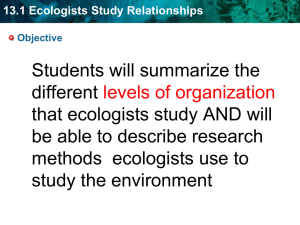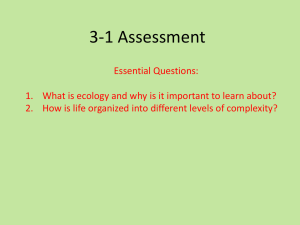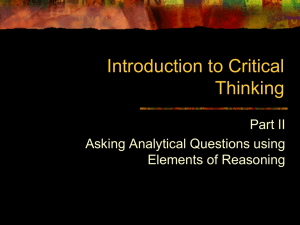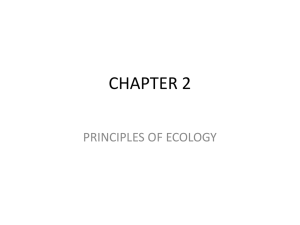13.1 Ecologists Study Relationships
advertisement
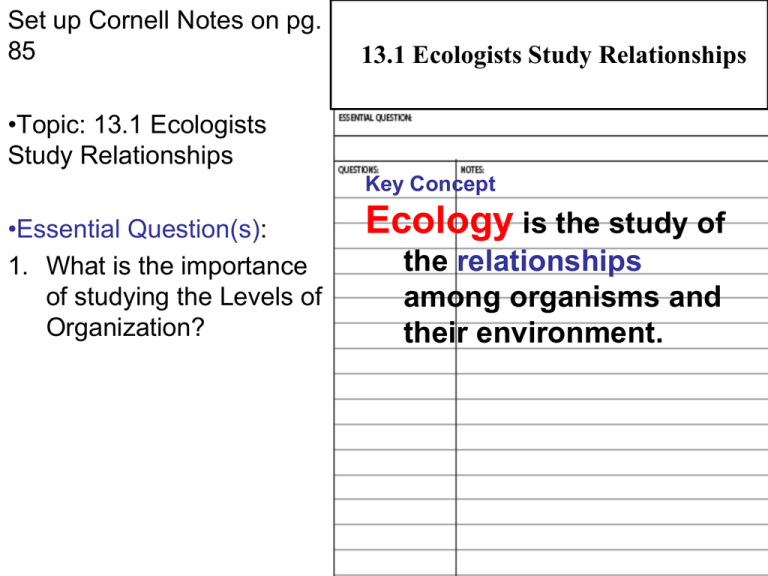
Set Cornell Notesand on pg. 31.1upPathogens Human Illness 85 13.1 Ecologists 2.1 Atoms, Ions, Study Relationships and Molecules •Topic: 13.1 Ecologists Study Relationships Key Concept •Essential Question(s): 1. What is the importance of studying the Levels of Organization? Ecology is the study of the relationships among organisms and their environment. 31.1 Pathogens and Human Illness PLEASE TURN IN “LABEL THAT PIG” 13.1 Ecologists Study Relationships Pg. 84 What does the word relationship mean to you? • examples 31.1 Pathogens and Human Illness Introduction to Ecology (3m20s) 13.1 Ecologists Study Relationships Key Concept Ecology is the study of the relationships among organisms and their environment. 13.1 Ecologists Study Relationships Ecology is the study of the interactions among living things, and between living things and their surroundings. Pg. 84: If you were an ecologist, what types of questions would you want answered about this Grizzly Bear? 13.1 Ecologists Study Relationships • A bear’s interactions with other living things • Social interactions with other bears? • What animals and plants does it interact with? • In its surrounding • Where it lives • What does it eat? 13.1 Ecologists Study Relationships Ecologists study environments at different levels of organization. 13.1 Ecologists Study Relationships Levels of Organization • Ecologists study nature on different levels, from a local to global scale • These levels, reveal the complex relationships found in nature 13.1 Ecologists Study Relationships Name those Levels of Organization! 13.1 Ecologists Study Relationships Organism 13.1 Ecologists Study Relationships Population Organism 13.1 Ecologists Study Relationships Population Organism Community 13.1 Ecologists Study Relationships Ecosystem Population Organism Community 13.1 Ecologists Study Relationships Biome Ecosystem Population Organism Community 13.1 Ecologists Study Relationships Biosphere Biome Ecosystem Population Organism Community 13.1 Ecologists Study Relationships What type of ecosystem is portrayed in this picture? 13.1 Ecologists Study Relationships 1. An organism is an individual living thing Ex: alligator Organism Organism 13.1 Ecologists Study Relationships 2. A population is a group of the same species that lives in one area Ex: alligators Population Population 13.1 Ecologists Study Relationships 3. A community is a group of different species that live together in one area. Ex: alligators, turtles, grass, and birds. Community Community 13.1 Ecologists Study Relationships 4. An ecosystem includes all of the living organisms as well as the nonliving things Ex: All animals, plants, soil, water, rocks and other nonliving things Ecosystem Ecosystem 13.1 Ecologists Study Relationships 5. A biome is a major regional or global community of organisms characterized by the climate conditions and plant communities that thrive there. Ex: Tropical rainforest, grassland, desert, deciduous forest, rain forest, taiga, tundra Biome 13.1 Ecologists Study Relationships With a partner: Create your own Levels of Organization Diagram Must include: each L.O.O, labels, color, circles, one paragraph description of your diagram describing what is in each level (may NOT use the example provided in class) *Might be easier to start with an animal you know something about Pg. 397 Organism: 1 animal (Alligator) Population: animals (Alligators) Community: animals and plants (Alligators, turtles, birds, moss,) Ecosystem: living and non-living Biome: desert, ocean, chaparral, rainforest, forest, mountains, fresh water, grassland, savanna, etc…. (463) 13.1 Ecologists Study Relationships Levels of Organizations • Ecologists study relationships within each level of organization and also between levels – For example, researchers may study the relationships within a population of alligators, as well as relationships between alligators and turtles in a community 13.1 Ecologists Study Relationships Ecological Research Methods • Scientists rely on a variety of methods and tools to conduct research • Tools can range form a simple tape measure used to find an organism’s size to a sophisticated computer model of an entire ecosystem 13.1 Ecologists Study Relationships Ecological research methods: 1. Observation is the act of carefully watching something over time. 13.1 Ecologists Study Relationships –Direct surveys used for species that are easy to follow. Ex: You count how many deer are in the field –Indirect surveys are used for species that are difficult to track and include looking for other signs of their presence. Ex: Looking for feces or a recent kill 13.1 Ecologists Study Relationships 2. Experiments: Lab experiments • Give researchers control Ex: You want to test how a fungus reacts to heat. In your lab experiment you turn up the temperature. • Done inside Negative: not reflective of the complex interactions in nature. 13.1 Ecologists Study Relationships Field experiments • give a more accurate picture of how organisms interact in a natural setting • performed where the organisms live Negative: may not help determine actual cause and effect. Ex: You want to know the effect deer have on a type of grass in the forest, so you block off a part of the forest to keep out the deer. By monitoring the fenced and unfenced area, you can determine the deer’s effect on the grass. 13.1 Ecologists Study Relationships If observation and experimentation don’t work…turn to modeling 3. Modeling allows scientists to learn about organisms or ecosystems in ways that would not be possible in a natural or lab setting. • Computer and mathematical models can be used to describe and model nature. Ex: GPS transmitter Ecologists use data transmitted by GPS receivers worn by elephants to develop computer models of the animal’s movements. GPS transmitter 13.1 Ecologists Study Relationships GPS and Elephant Conservation • GPS and Anti-poaching Effort(1m44s) http://www.youtube.com/watch?v=sSoI5dvtZcc 13.1 Ecologists Study Relationships Estimating Population Size Activity • Objective: Estimate the size of a sample population using the mark-recapture technique. Be able to apply the technique to new population problems and compare the mark and recapture technique to other methods of population estimation. 13.1 Ecologists Study Relationships Classwork pg. 84 (398-400 in book) • Summarize the three general methods used by ecologists to study organisms • Come up with NEW examples of each 1. Apply: What ecological research methods would you use to study bird migration? Explain. 2. Apply: How might an ecologist use modeling to study fire in a forest ecosystem? What might be some key variable used to create the model?
